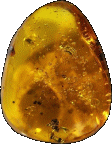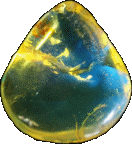| |
Amber
|
The Greek name for amber was ēlektron (ἤλεκτρον). This name was later bestowed upon electrum, the amber colored alloy of gold and silver. It is also the origin of the modern word for electricity, due to ambers ability to hold a static charge. This property is referenced many times in old lapidaries. Since these were written before modern understanding of charged electrons, a word also related to the name of amber, the accounts tell of the stone “drawing” or “attracting” fibers or dust. The modern name amber is thought to be of middle eastern origin.
Amber is one of the four organic gems. Though often referred to as a “fossilized resin” this material is not actually a stone, as no mineral replacement has occurred. It is crystalized resin of various ancient conifers, the oldest of which date to around 320 million years ago in the Upper Carboniferous period. The use of amber as an ornamental stone date back to the neolithic, making it one of the oldest gemstones known to humanity.
Humanities contact with amber has spawned multiple myths as the cultures that held it sacred rose and fell. It has been said to be solidified sun beams, the tears of lamenting trees and bird, and drops of divine honey. But perhaps one of the most interesting stories is one recounted by Pliny as he is disputing earlier Greek myths where he quotes Democritus as claiming that amber was the solidified urine of the lynx, and that the richly colored golden and red amber came from the male and the lower grade waxy sort from the female. This is interesting because he seems to referencing a myth that both establishes a relationship between the substances that we call amber and copal, and a distinction between the two. It gets more interesting when Pliny later recounts a story by the Chaldean philosopher Sudines who correctly identifies amber as the product of tree, but goes on to explain that in Etruria, this tree is known by the name of "lynx". It may well be that the earliest account by Sudines was accurate and that the later myth was prompted by a false cognate during later retellings.
Amazingly enough after recounting all of the fables associated with amber, Pliny accurately describes amber as being “produced from a marrow discharged by trees belonging to the pine genus, like gum from the cherry, and resin from the ordinary pine. It is a liquid at first, which issues forth in considerable quantities, and is gradually hardened by heat or cold, or else by the action of the sea, when the rise of the tide carries off the fragments from the shores of these islands.” Though he misidentifies the source of hardening, or crystallization, he correctly identifies that it is the result of environmental factors acting upon the sap of the pine that creates this precious stone.
The virtues of this stone vary widely but are always of a protective nature. Pliny reports that during his time German women often wore amber pendants to prevent goiters and diseases of the throat. This may be an over simplification due to cultural ignorance, as he later explains that amber is worn in Rome to protect from madness, fevers, disease and urinary problems.
Many of these stories often involve the protection of children or women during childbirth. Amulets would be worn by pregnant women or nailed to the cradles of children to keep evil spirits at bay. This should not be mistaken as support for the modern folklore involving giving children amber necklaces. That is purely a commodified idea intended to sell cheap necklaces at exorbitant prices. This is even more problematic given that children can split the soft beads and choke on these necklaces. It is also worth noting that the majority of such necklaces being sold as amber are plastic knockoffs. One of the easier ways to check this is to shine a black light onto the stone, real amber has an eerie blue green hue. This is not perfect as some of the higher end fakes have begun to add reactive dye to the plastic to mimic the test, but if there is no greenish blue shine it is not real amber.
In medieval Europe amber was believed to be able to detect poisons and discern the virtue of paramours by changing color. It was set into drinking vessels and if the stone should change appearance it was thought to indicate the presence of poison. In the same way any gifts of amber were thought to reflect the affection of the giver, a change or loss of color was to be interpreted as a sign of a dying love. This changing of color as a form of divination is both common and unfortunate in gems that tend to undergo environmental wear like the opal or amber. Regularly worn soft stones will often change color as they absorb sweat or oils from the wearer, or are altered by changes in heat or humidity in the environment.
A more interesting test of fidelity using amber comes from the Speculum Lapidum. In this text Camillo Leonardi claims that it is possible to detect an unfaithful wife by placing a bit of amber on her left breast while she is sleeping. The stone is then placed in water for three days before being shown to her. If she is guilty, she will immediately urinate. When reading this one has to wonder if this practice was common knowledge. If so, it may be that the wife voided her bladder when the stone was presented because she knew it was a threat to her livelihood if not personal safety. This would make the wife’s act of urination a fear based involuntary response separate of any other actions on her behalf.
It is also thought to be a powerful charm against demons and sorcery. This may perhaps be due to ambers association with static electricity. The sparks of static discharge must have seemed quite magical to preindustrial individuals seeing it in the darkness of a candle lit room. Amber and jet were of special significance to folk healers in northern Europe, prized for their abilities to turn back evil and protect against sickness and disease. This tradition has been adopted my wiccans and other neopagans as the “Witch’s Cord” or “High Priestess Necklace”. This is a was originally a talisman of amber and jet, but is now usually thought of as a necklace of amber and jet beads. In this context the combination is of more importance than the morphology of the artifact.
|
Colors
|
All shades from golden yellow to cherry red
|
Locations
|
Baltic Sea, Dominican Republic, Indonesia
|
Composition
|
C10H16O. Crystallized pine resin.
|
Hardness
|
2 - 3
|
|

|

|

|
|
|
|
|
|